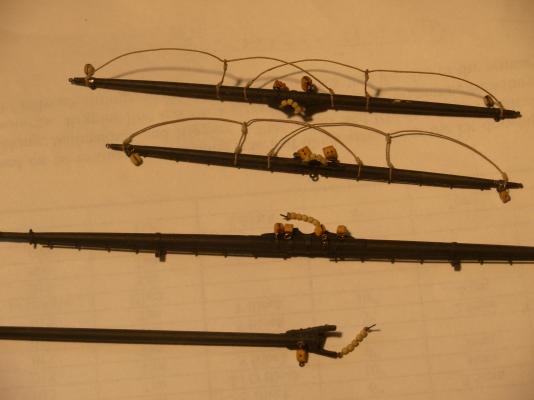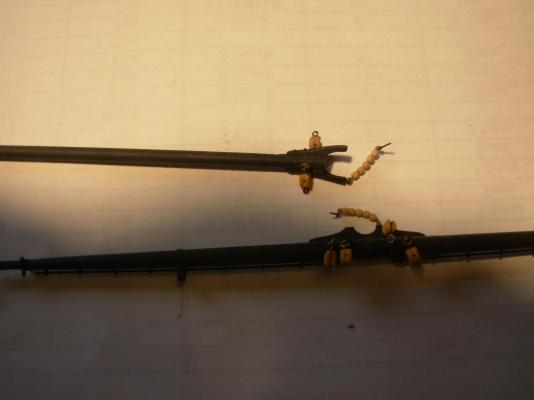-
Posts
126 -
Joined
-
Last visited
Content Type
Profiles
Forums
Gallery
Events
Posts posted by ulrich
-
-
-
Looking at an older kit of Mamoli's Gretel, CM stands for Mahogany Plywood.
Hope this will help.
Ulrich
- GrandpaPhil, Gregory and mtaylor
-
 3
3
-
I used all metal parts which are supposed to be used as panels, doors, windows etc. on the deck cabins and hatches as templets to make them out of thin plywood, mahogany, dowels.
The larger pieces with the squares to be cut out are attached to the outside of the upper bulwark topped by the hand rail. (See my pics. here).
Regards,
Ulrich
- Jeremy vdb and mtaylor
-
 2
2
-
What criteria defines the term "semi scratch" build?
Ulrich
-
-
Hello Riotvan88<
I would create a slot to hold the keel to a wood base by gluing 2 square "dowels", as long as the entire keel, wide enough apart to hold the keel tightly. Make sure these square "dowels" a low enough to not interfere with the bottom of the bulkheads. the bow and stern section of the false keel need to be held by square angles up to the top of bow and stern. This should keep the keel straight for now. After you have assembled the bulkheads to the keel you need to glue blocks between each bulkhead to keep it straight. Better would be to fill all the voids between the bulkheads and make it a solid hull. For that, I would use bass wood, no balsa wood. Good luck
Ulrich
-
I have used several different sizes of chain on my Cutty Sark (1:78), down to about 47 l/in. However, instead of chain for the the sheets, I used bead cord. I obtained this (nylon?) material from my local jewelry store. It comes in diff. colors and sizes and really looks like chain considering the small scale it is to represent. The drawback is that it might twist when its stretched.
Ulrich
-
Ahoy everyone,
Concerning the flying stay sail on the Katy of Norfolk: can anyone enlighten me were on the fore mast to place the small block (3/32) for the down haul and the bulls eye for the upper tack?
Thanks for your help.
Ulrich
-
Great idea!!! It will make attaching the rat lines easier, faster and more realistic. One (two) question though about the sandpaper: what grit did you use and does the sand paper have any affect on the shroud lines? (ruffing them up?)
Ulrich
- EJ_L, mtaylor, thibaultron and 1 other
-
 4
4
-
Hi, you'all
a short update on the issue of parrel beads: I did purchase a bunch of toho beads but it turned out their holes are too large and that does not look right. My friend and mentor from the HRSMS (Hampton Roads Ship Model Society) pointed me in the right direction: take a hardwood dowel (I used holly), pull it through a draw plate to obtain the desired thickness, drill a small hole in the center (don't drill too deep, you might get off center), than cut it to the desired length with a sharp blade (#11), rolling the dowel against it to avoid pressure which could deform the dowel. I also made a small jig to get the same length for all beads. After that, I run these beads for a few seconds in my block tumbler to round their edges. This results in a bead not exactly round but slightly cylindrical. Dipping them into some wood oil will give them a "yellowish" color, same as boxwood (I think). The beads I made are slightly less than one mm in diameter and length which I think is appropriate for a 1/8" scale.
Happy modeling
Ulrich
-
-
Thanks for all the advise and tips. I don't have a lathe to turn those beads from wood (which would be my first choice). I will try to use the method, Jan describes, using clay. To round them off, I will run them in my block tumbler and see if that works. I'll keep you posted.
Thanks again,
Ulrich
-
Hello everyone!
For my current model, I need parrel beads the size around 1/32" or 0.8 to 1.0 mm. I have searched this web site, the internet and went to the lokal hobby store (Michaels) without satisfying results. Does anyone know where to purchase or how to make beads this small? Any help is greatly appreciated.
Kind Regards
Ulrich
-
they (Bluejacket) also sell a Brass Browning Solution which I used on their copper plates - looks fantastic!
Ulrich
-
I have mixed Wood Glue and Elmers Wood Filler for a stronger bond - it works well, but will not stain propperly.
Ulrich
-
Mark,
Even though it might be the "best kit available", it leaves much to be desired. I build the old version of this kit (better than the new) and spend more money on additional parts, materials, plans (G.F. Campbell), books etc. than the kit's price. (see pics in my gallery)
However, if you want to build the model using the kit only - it is a good kit.
Regards,
Ulrich
-
Thanks for posting this video! I learned a lot and explains the reasons for some of the frustrations, I experienced.
Regards,
Ulrich
-
Bluejacket Ship Crafters sells a product similar to Blacken It, but formulated to be used for Britannia Metal parts. Has anyone had any experience in using this product?
Ulrich
-
I have used the small eyelet from hundreds of fish hooks as jackstay eyebolts on my Cutty Sark (1:78) and on every block. The trick is to find the right size according to scale. I used Dry Fly Fishing Hooks, No. 14 and 16 for the CS. Since the eyelet on top of the hook is manufactured at an angle it needs to be bent straight again, most brands will brake during bending, they're made from steel. The only brand, I found that will not brake (or very few only) is MUSTAD from Norway. My fishing and hunting store always orders them for me.
For my current project (1:96 scale), I will even go smaller and will use No. 16, 18 and 20 Size. When using these eyelets in blocks, I have to make sure the remaining stem on the eyelet is short enough so it does not interfere with the sheave hole. That is kind of tricky.
Regards,
Ulrich
- CaptainSteve and 3qq
-
 2
2
-
I did experience similar problems while airbrushing basswood. I ended up using sanding sealer and primer, several coats after sanding it off repeatedly using up to 800 grit sandpaper. The primer needs to be compatible to the type of paint being used.
Regards,
Ulrich
-
Some years ago, I bought this "thing" from ME. Looked at it, tinkered with it and promptly threw it into the trash can.
Ulrich
-
I recently purchased an Enterprise kit made by Golden Kits(single planked). Is this an older version of the Constructo Kit? Does anyone have information about Golden Kits?
Thanks,
Ulrich
-
Thank you John and Russ,
I will take your advise and use rope in the appropriate size and color.
Regards,
Ulrich
-
Hello, Everyone,
I am starting to tackle the standing rigging on MS's Willie Bennett. The kit supplies 2 sizes of steel wire for the shrouds, Topping Lift, Head Stay and Fore Stay. I have no experience in using wire for rigging and would like to ask for help, tips and advise with this issue. My main concern is in regards to seizing, stretching, fraying and other possible problems. Should I use rope instead of wire?
Thanks for your help.
Kind regards,
Ulrich





Floquill Bright Oil
in Painting, finishing and weathering products and techniques
Posted
Thanks, TMJ,
I will try it.